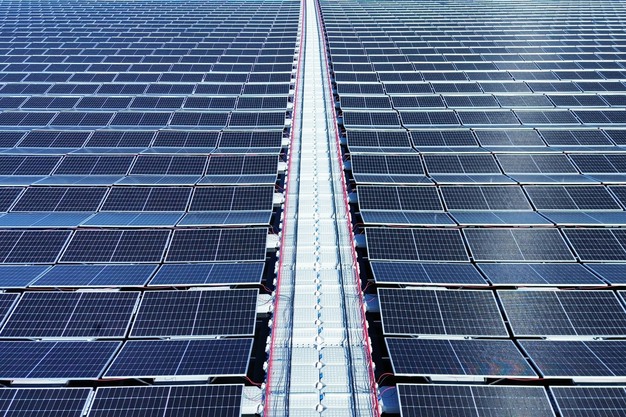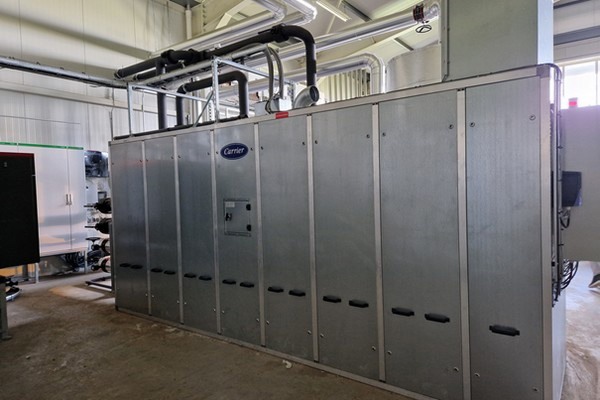Tomato grower Martin van der Gaag has implemented a comprehensive suite of energy technologies to provide heat and electricity for his greenhouse. The growers' cooperative Oxin Growers invested in solar panels for the Dutch grower, installing them on the existing water basins.
Located in Luttelgeest, the expansive tomato-growing operation spans 29 hectares of greenhouses, where Martin cultivates large vine tomatoes. As a second-generation grower at 42, he manages the family business. His 71-year-old father remains active in the business, and his sisters also contribute to its operations.
Martin is a grower with a literal green thumb, as evidenced when we speak to him in mid-March while he stands on the embankment of the water basin. He enjoys being among the tomatoes, but as a modern entrepreneur in greenhouse horticulture, he also focuses on energy management and the various techniques and challenges it entails.
 © Zon op Waterbassin
© Zon op Waterbassin
"To get the whole company in the picture, I had to go up quite a bit with my drone," laughs the cameraman who is recording a video during the visit.
Electricity and water quality
The tomato-growing company now comprises two greenhouses. The most recent expansion occurred in 2020, adding 3 hectares to the operation. Subsequently, the rainwater storage capacity was increased with the addition of a third water basin. Since the end of last year, solar panels have been installed on all the water basins, collectively providing about 750,000 m³ of water storage. Oxin Growers, with the assistance of a SIG&F subsidy, invested in the Aquasol Solar system for Tomatenkwekerij In de Polder.
A total of 6,700 solar panels are installed on floats in the water basins using an innovative system. This system features special anchoring, ensuring it can withstand the strong winds often experienced in the sometimes windy polder.
Besides the advantage of generating a lot of electricity themselves, improving water quality also plays a role. "That improvement in water quality is a nice bonus," the grower says. "Summers are getting hotter and drier." Last year, Oxin Growers also installed cavitating ultrasonic USAF™ transmitters from Ultramins in the water basin, where the grower also pumps in osmosis water.
The company's transmitters, with which Aquasol Solar collaborates on projects with solar panels on water basins, help prevent algae growth. The Ultramins system also works against bacteria, fungi, and viruses. The water at the grower is nice and clear in mid-March. "I see that the transmitters are doing what they are supposed to do," says Martin, pointing to the clearly visible bottom of the basin.
 © Aquasol Solar
© Aquasol Solar
A sea of solar panels on the water basins provides the tomato grower with electricity, generated at 1 to 2 cents per kilowatt-hour.
Generating heat from electricity instead of with a gas boiler
In a short time, Oxin Growers invested in the tomato growing company not only in solar panels on Aquasol Solar's water but also in solar panels on the roof of the shed where the grower packs tomatoes, in an e-boiler, and a heat pump. In addition, the tomato grower has 9.5 megawatts of CHP capacity and receives geothermal heat from the nearby geothermal project. The rising energy tax makes gas boilers very expensive. The new technologies offer grower Martin an alternative.
All the electricity the company can generate with the solar panels and the CHP, Martin uses as much as possible within the company. It helps that there is now an e-boiler and a heat pump in his shed. "With these systems, we can also generate heat with electricity."
The grower works with export monitoring for feeding electricity back. "Consultancy DNO Energy helps us with this. If we exceed 6 megawatts, the electricity goes to the e-boiler." Like many regions, the region where Tomatenkwekerij In de Polder is located also has to deal with this.
Recently, a tank with liquid CO₂ was also installed. Fewer operating hours with CHP and boiler also means less own CO₂ generation. The availability of liquid CO₂ compensates for this.
 © Thijmen Tiersma | HortiDaily.com
© Thijmen Tiersma | HortiDaily.com
Heat pump in the shed
"The panels are never off"
At Aquasol Solar, which has now realized more than thirty such projects with solar panels on water basins at home and abroad, they know that the package of new energy techniques that the tomato grower has is quite exceptional. Moreover, it is special that in a short time many new systems have been added to the option package with CHP and boiler. "I went from 0 to 9,500 solar panels in one year," Martin emphasizes his amazement.
 © Zon op Waterbassin
© Zon op Waterbassin
Inverters next to the water basin. The harder the sun shines, the more they zoom to stay cool. Huawei's inverters are housed in a specially designed shelter, which is uniquely designed for each project, explains Richard Nieuwenhuizen, project leader on behalf of Aquasol Solar at the Luttelgeest project. "With the specially designed shelter, we achieve maximum cooling of the inverter. This benefits the lifespan of the inverter."
The premise is that the solar panels are never off. To keep everything on track, inverters are placed next to the water basin and in the shed. These are part of the total package that Aquasol Solar delivers in collaboration with Huawei.
In addition, a new transformer station is coming. When that station is also installed this spring, the entire operation will be completed, and grower Martin can provide his greenhouse with energy with a lot of self-generated electricity to grow tomatoes optimally. Both the solar panels and the tomatoes, which were planted for Christmas, could use some sun after a dark winter period. "The first cluster is just starting," Martin notes on Wednesday morning in mid-March.
For more information:
Aquasol Solar
welkom@aquasolsolar.nl
www.aquasolsolar.nl
Oxin Growers
info@oxin-growers.nl
www.oxin-growers.nl
